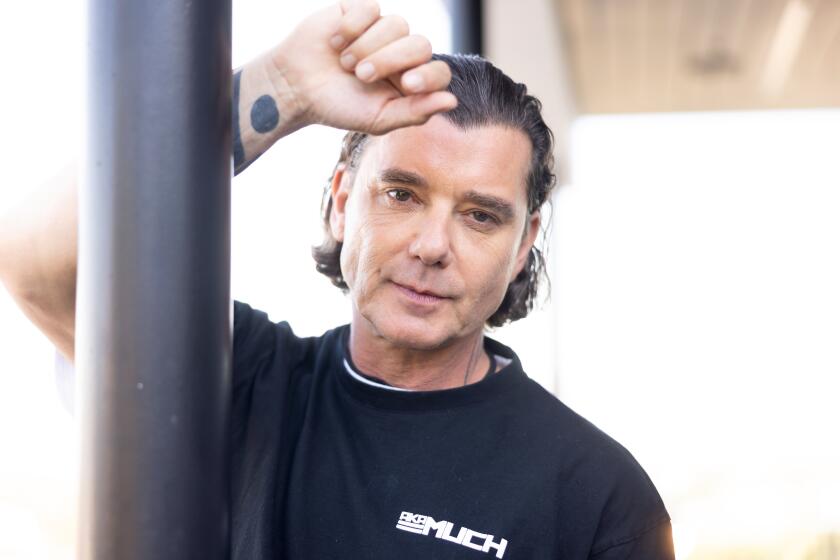‘It’s like a stroll through the Louvre:’ PBS’ ‘Soundbreaking’ shows the magic of music-making
- Share via
Whether the rush of harmonies in “Wouldn’t It Be Nice,” the thrilling beat of Little Richard’s “Keep a Knockin’” or the delicate lyricism of Joni Mitchell’s “California,” music’s ability to carry us into the sublime often suggests that its creation is somehow divinely inspired.
But as the new eight-part PBS documentary “Soundbreaking” shows, the evolution of recorded music is the result of human sweat, tinkering, innovation and experimentation. The series, which will make its U.S. broadcast debut on Nov. 14 on PBS, was the final creative project of George Martin, whose production work with the Beatles transformed pop music in the 1960s.
Martin died in March after “Soundbreaking” was finished, and his presence in exploring the secrets of the recording studio is felt throughout the episodes. So are the echoes of his influence, which are laid out in detail through interviews with dozens of acclaimed musicians and producers including Paul McCartney, Nile Rodgers, Sheila E., Tricky Stewart and producer-songwriter Linda Perry, as well as insights from critics including Jody Rosen and Oliver Wang.
Their thoughts are woven through rare footage of studio sessions by artists including the Beatles, Adele, Sly Stone, Janis Joplin, Fleetwood Mac, Little Richard, Amy Winehouse, the Beach Boys and the Staples Singers, all of which offer exuberant illustrations of the interplay between music and technology.
The series, which was produced and directed by filmmakers Maro Chermayeff and Jeff Dupre, came as the result of Martin’s sense that the story of music had never been told from the angle of recording music and the art of capturing sound on tape.
The goal, said Chermayeff, was to use “a framework of technology and recording as a way of looking at the evolution of popular music. How those technologies and how those shifts in focus around producing really changed the artist, changed the music and changed the whole medium.”
“Producers were people who understood how recording worked,” says studio wizard Brian Eno during the opening episode. “They were the people who said, ‘Here’s this whole new set of possibilities. We’re going to find out what they can do.”
Martin and the producers do so by breaking down the elements and history of capturing sound in a recording space. One episode is devoted to the human voice and the ways in which producers have recorded and manipulated it, and features segments on Frank Sinatra’s candlelit croon, Kanye West’s “Love Lockdown” Auto-Tune and Adele’s foot-stomping recording of “Rolling in the Deep.”
Another episode focuses on sampling, illuminating the technology that allowed for the rhythmic looping of recorded audio. It draws on footage and interviews with producer and actor RZA of Wu-Tang Clan, Beastie Boys’ Adam Horovitz and jazz-funk legend Herbie Hancock, among others. The installment called “I Am My Music” explores the history of formats such as vinyl, tape, MP3 and streaming.
“It’s like a stroll through the Louvre, in a way,” said Dupre, adding that the goal was to explore themes via “artists who epitomize some form of innovation in different eras. It’s like there’s a conversation happening between generations of artists and listeners.”
What they and Martin didn’t want was a dry historical chronology of recorded music. Instead, they wanted to crack open songs to show what makes them tick, and why they resonated with the masses.
“These songs are very intricately constructed and there’s a reason why they touch us so deeply,” said Dupre. “It’s because they’re so well built, and the series really gives you a primer to understand how they did it.”
In breaking down Little Richard’s “Keep a Knockin’,” for example, the legendary rock ’n’ roller’s drummer Charles Connor recounts Little Richard taking him to a train station to describe the beat he was looking for.
Pointing out the “chug-chug” sound of a locomotive as it accelerated, recalled Connor, “He said, ‘What kind of notes are those?’ I said, ‘Those are eighth notes.’ And he said, ‘Well that’s what I want you to play behind me.’”
The same episode connects the hand-clapping as delivered in Beyoncé’s “Single Ladies (Put a Ring On It)” with the sanctified gospel celebrations of black church sanctuaries.
Footage shows “Single Ladies” co-writers the-Dream and Tricky Stewart breaking down the song track by track, starting with the beat. As Stewart plays the song’s rhythm, the-Dream recalls writing the lyrics to the beat: “I just sat in the back and thought, ‘If I was Beyoncé, I would say what?’”
You’ll never hear the song the same way again.
There’s a lot of terrible music out there. For tips on the stuff that’s not, follow Randall Roberts on Twitter: @liledit
ALSO
‘It’s pretty fun to hate people’: What Jeff Tweedy says about making Wilco’s most unsettling album
More to Read
The biggest entertainment stories
Get our big stories about Hollywood, film, television, music, arts, culture and more right in your inbox as soon as they publish.
You may occasionally receive promotional content from the Los Angeles Times.










